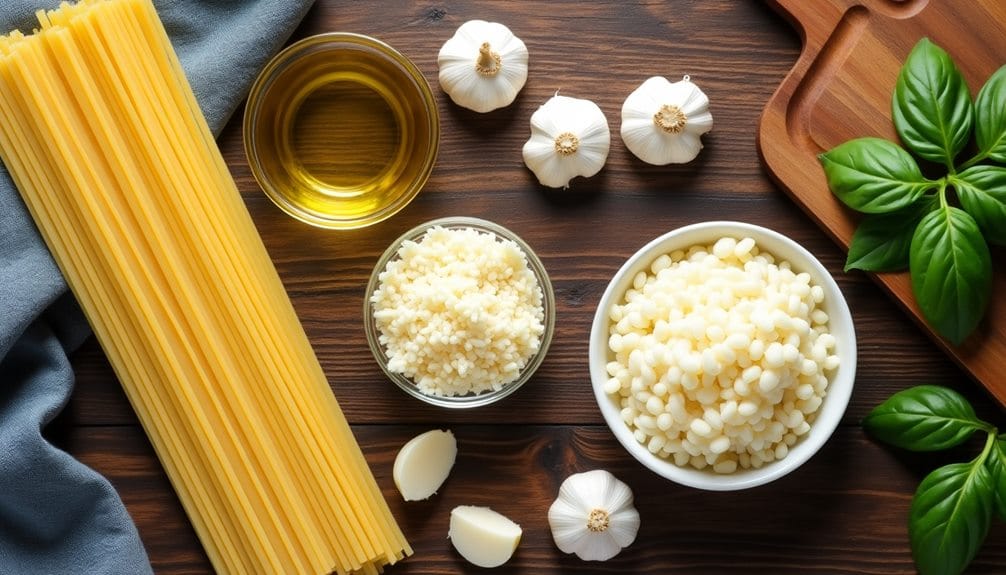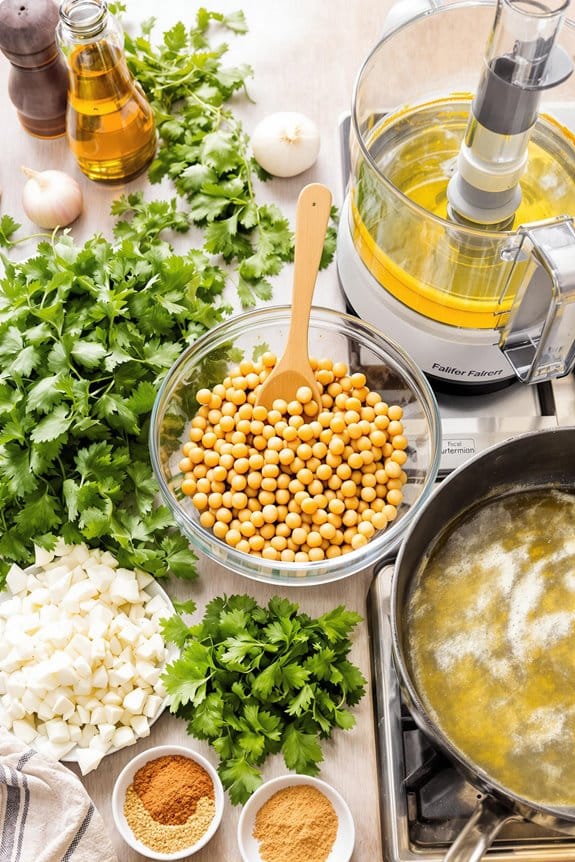Did you know that the art of pasta making dates back to the 13th century in Italy? It’s a tradition that’s been passed down through generations, making it an intrinsic part of Italian culture. On Italian Pasta Night, you get the chance to immerse yourself in this culinary heritage. You’ll learn about the different types of pasta, how to cook them to perfection, and how to pair them with the right sauces. Interested in discovering why pasta is such a beloved staple in Italy and how you can bring this tradition into your own kitchen? Stay tuned.
History
While you might associate pasta with Italy, its origins are actually a topic of hot debate among historians. Some argue that it was brought to Italy by Marco Polo from his travels to China. Others argue that pasta was already in Italy long before Polo’s time, brought by the Arabs during their invasion of Sicily in the 8th century.
What’s not in dispute, however, is that pasta’s popularity soared in Italy in the 13th century, becoming a staple food of the Italian diet. Over time, different regions in Italy developed their own pasta dishes, using local ingredients and creating a variety of shapes. The versatility of pasta and its ability to be paired with a broad range of ingredients contributed to its beloved status in Italian cuisine.
In the 18th century, pasta began to be produced commercially, leading to its widespread availability and making it an affordable food for all classes. Today, pasta is synonymous with Italian cuisine, enjoyed worldwide and celebrated for its versatility, simplicity, and delicious taste. Regardless of its true origins, one thing is clear: Pasta has found its home in Italy.
Recipe Cooking Steps
Indulge in the classic flavors of Italy with our Italian Pasta Night recipe. This simple yet flavorful dish brings together all the key elements of Italian cuisine – garlic, olive oil, Parmesan cheese, spaghetti, and fresh basil leaves. It’s a perfect choice for a romantic at-home dinner date, a comforting family meal, or even a one-person feast. With just five main ingredients, this dish is a breeze to prepare, yet it delivers a hearty and deeply satisfying meal.
The beauty of this dish lies in its simplicity. The minimalist recipe allows the natural flavors and textures of the ingredients to take center stage, creating a truly authentic Italian dining experience. Each ingredient plays a vital role in the dish, from the garlic-infused olive oil that coats the pasta to the fresh basil leaves that add a pop of color and a burst of freshness.
Here are the ingredients you’ll need:
- 200 grams of spaghetti
- 4 cloves of garlic
- 3 tablespoons of olive oil
- 1/2 cup of grated Parmesan cheese
- A handful of fresh basil leaves
To start, boil the spaghetti according to the package instructions until it is al dente. Simultaneously, heat the olive oil in a large skillet over medium heat and sauté the garlic until it turns golden brown. Once the spaghetti is cooked, drain it but be sure to save some of the pasta water. Add the spaghetti to the skillet with the garlic and mix well to coat the pasta in the garlic-infused oil. If needed, add some of the reserved pasta water. Turn off the heat and stir in the grated Parmesan cheese and fresh basil leaves.
When preparing this dish, remember these helpful tips. First, use high-quality olive oil and fresh garlic to guarantee the best flavor. Second, don’t forget to reserve some pasta water after cooking the spaghetti. The starchy pasta water will help to create a smooth, creamy sauce when mixed with the Parmesan cheese. Finally, add the cheese and basil just before serving to maintain their texture and flavor. This dish is best enjoyed immediately after preparation to get the most out of its flavors and textures. And don’t be afraid to make it your own – feel free to add extras like cherry tomatoes or grilled chicken for an even more substantial meal.
Step 1. Boiling the Spaghetti
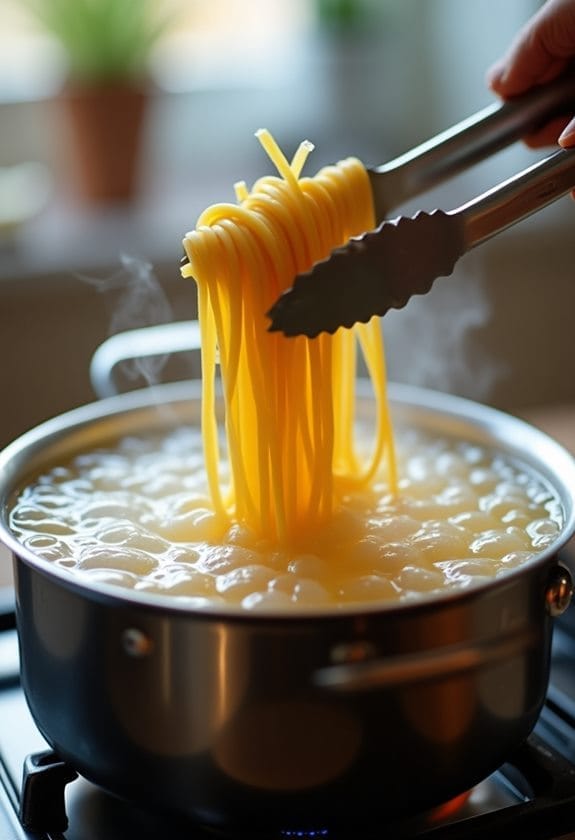
First up, let’s get your spaghetti perfectly cooked. It all begins with water – plenty of it. You’ll need about 4 liters for every 200 grams of spaghetti. Salt it generously, it should taste like the sea. This is your only chance to season the pasta itself, so don’t be shy.
Once the water is boiling, add your spaghetti. Stir it immediately to prevent it from sticking together. Now, patience is key. Let your spaghetti boil, but keep an eye on it. Don’t rely on the packet instructions for timing – it’s best to test yourself. After about 8 minutes, fish out a strand and have a taste. You’re aiming for al dente, which means it should still have a bit of bite.
When it’s ready, don’t just drain it. Save a cup of the pasta water first. Trust me, this starchy liquid is gold – it will give your sauce the perfect consistency later. Then, drain your spaghetti, but don’t rinse it. The starch on the surface helps the sauce stick. And just like that, you’ve nailed boiling spaghetti. Now, onto the next step.
Step 2. Sautéing Garlic in Olive Oil
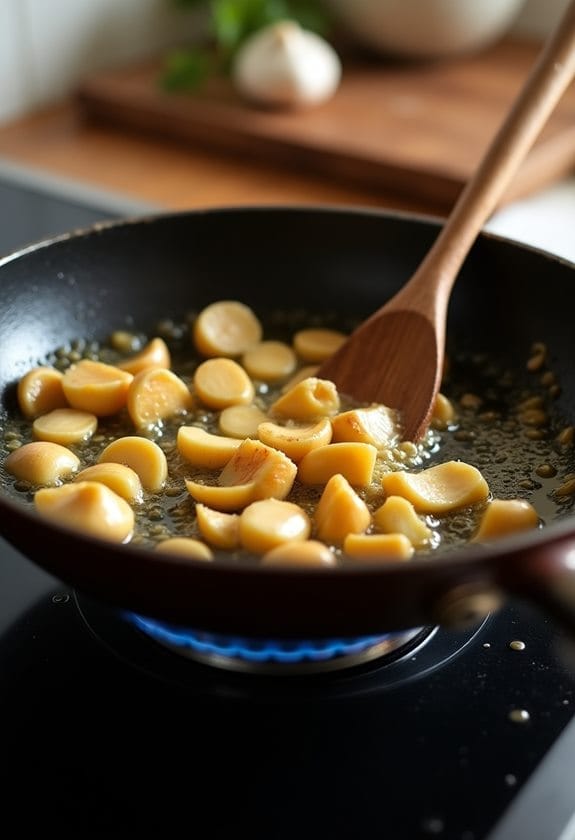
Now it’s time to release the bold flavors of garlic and olive oil, a quintessential combination in Italian cuisine. This step elevates the simplicity of classic spaghetti to a whole new level of gastronomic delight. Start by peeling and finely chopping your garlic. You don’t want large chunks, but a nice, fine mince.
Now, set a large skillet over medium heat and pour in your olive oil. Swirl it around the pan to make sure it’s evenly distributed. As soon as it’s heated, it’s time to add your minced garlic. Be careful not to let the oil get too hot or else the garlic will burn. You’re aiming for a beautiful golden color that brings out the garlic’s natural sweetness.
Sautéing garlic in olive oil is more than just cooking; it’s an art. You’re infusing the oil with the garlic flavor, creating a base for your pasta dish that’s rich and aromatic. Remember to stir constantly, ensuring all your garlic gets evenly sautéed. Don’t rush this process. Take your time and let the flavors meld together. The end result will be nothing short of spectacular.
Step 3. Adding Spaghetti to Skillet
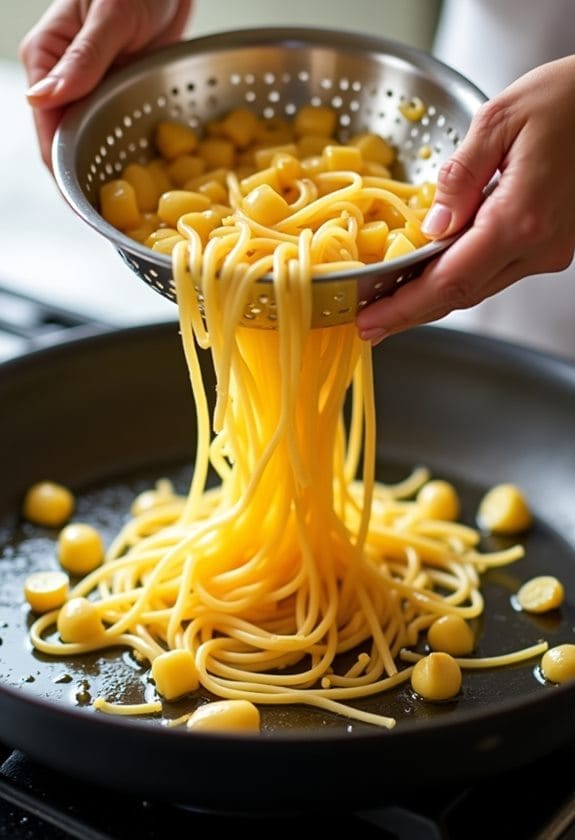
Once your garlic has reached that perfect golden hue, it’s time to introduce the spaghetti to its aromatic companion. You’ve done well by boiling your spaghetti till it’s al dente, the perfect balance of firm and tender, and now it’s showtime in the skillet.
In goes the drained spaghetti into the skillet. You’re not just dumping it in there, you’re carefully incorporating it into the symphony of garlic-infused olive oil that’s been patiently waiting. Toss it around a bit, let every strand get acquainted with that luscious golden oil.
But wait, it looks a bit dry? No worries! Remember that pasta water you saved? Now’s the time to introduce that back into the mix. Just a little at a time, mind you. You’re looking for a perfect blend, not a soup.
And there you have it! Your spaghetti is now luxuriating in a bath of garlic and olive oil, absorbing all those fantastic flavors. You’re almost at the finish line, just remember not to move on to the cheese and basil quite yet. Those are the final touches to this masterpiece.
Step 4. Mixing in Cheese and Basil
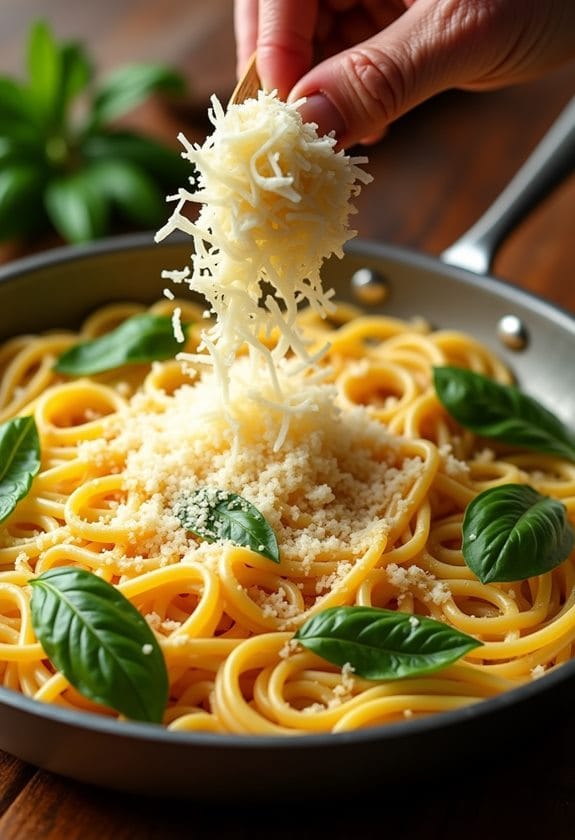
Drawing the cooking process closer to its delicious conclusion, you’ll find that the addition of the Parmesan cheese and fresh basil leaves transforms your dish from good to truly remarkable. The moment you sprinkle that golden Parmesan onto your pasta, it begins to melt, intertwining with the spaghetti strands and garlic-infused oil, creating an irresistible creamy texture.
Don’t be stingy with the cheese; it’s the heart of this dish, imparting a rich, salty depth that’s beautifully balanced by the aromatic basil. When you’re ready to introduce the basil, tear the leaves gently with your hands over the pasta. This releases their essential oils, infusing the dish with a fresh, peppery essence that cuts through the richness of the cheese.
But remember, timing is everything. Mix in the cheese while the pasta’s still hot so it melts seamlessly, and add the basil last to keep it vibrant and green. Take care not to overcook the basil; its flavor is delicate and can be easily lost with too much heat. With these final steps, you’ve elevated your pasta dish to a whole new level, promising a truly Italian experience with each bite.
Step 5. Serving the Pasta Immediately
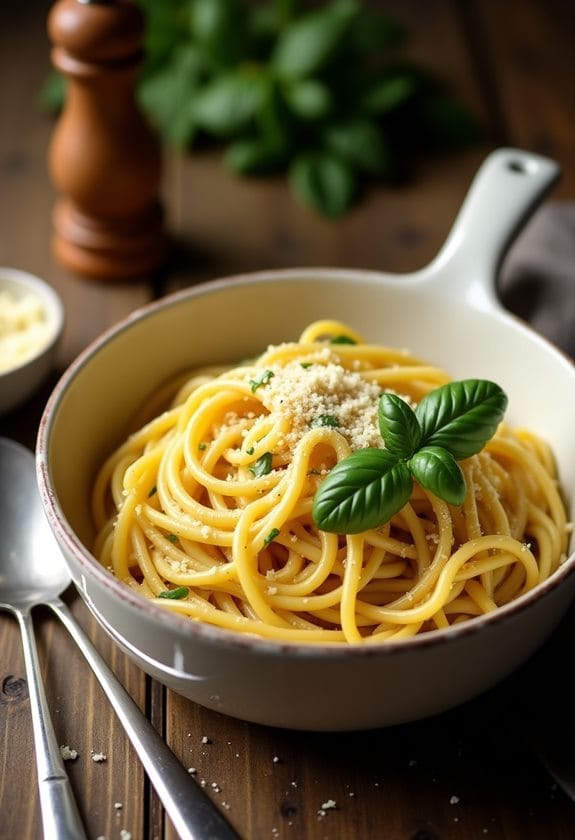
The moment your Italian Pasta Night dish is complete, it’s crucial to serve it immediately. Why’s that, you ask? Well, pasta is best enjoyed hot, and you don’t want the spaghetti to start sticking together or the cheese to cool off and lose its melt-y goodness.
As you transfer the pasta from the pan to the serving dish, do it briskly. You’ve put in all that effort creating a beautiful meal, the last thing you want is for it to lose its allure before it even hits the table. And remember, presentation is key. Consider garnishing with a few extra basil leaves for a pop of color and a burst of freshness.
Serving your pasta hot also guarantees that the fragrant aroma wafts throughout your dining area, whetting everyone’s appetite. There’s something about the tantalizing smell of garlic and cheese that’s simply irresistible.
New Recipe
- Pepperoni and Hot Honey PizzaTry the tantalizing twist of pepperoni pizza with hot honey, where sweet meets heat—how will it transform your taste buds?
Final Thoughts
After all is said and done, you’ll find that this Italian Pasta Night recipe is a delightful treat that’s not only easy to make but also incredibly satisfying. It captures the essence of Italian cuisine, using simple ingredients that deliver robust flavors.
With a bit of preparation and attention to detail, you can effortlessly bring this meal to life. Remember to use high-quality olive oil and fresh garlic for the best results. The starchy pasta water and Parmesan cheese create a creamy, emulsified sauce that’s just divine. Add the cheese and basil just before serving to maintain their freshness.
This dish is versatile, feel free to add items like cherry tomatoes or grilled chicken. Serve it immediately to savor the full flavors and textures. You’ll be amazed at how a meal this simple can be so utterly satisfying.

